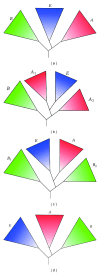Close encounters of the third domain: the emerging genomic view of archaeal diversity and evolution
- PMID: 24348093
- PMCID: PMC3852633
- DOI: 10.1155/2013/202358
Close encounters of the third domain: the emerging genomic view of archaeal diversity and evolution
Abstract
The Archaea represent the so-called Third Domain of life, which has evolved in parallel with the Bacteria and which is implicated to have played a pivotal role in the emergence of the eukaryotic domain of life. Recent progress in genomic sequencing technologies and cultivation-independent methods has started to unearth a plethora of data of novel, uncultivated archaeal lineages. Here, we review how the availability of such genomic data has revealed several important insights into the diversity, ecological relevance, metabolic capacity, and the origin and evolution of the archaeal domain of life.
Figures


Similar articles
-
Genomic exploration of the diversity, ecology, and evolution of the archaeal domain of life.Science. 2017 Aug 11;357(6351):eaaf3883. doi: 10.1126/science.aaf3883. Science. 2017. PMID: 28798101 Review.
-
Genomic studies of uncultivated archaea.Nat Rev Microbiol. 2005 Jun;3(6):479-88. doi: 10.1038/nrmicro1159. Nat Rev Microbiol. 2005. PMID: 15931166 Review.
-
Exploring microbial dark matter to resolve the deep archaeal ancestry of eukaryotes.Philos Trans R Soc Lond B Biol Sci. 2015 Sep 26;370(1678):20140328. doi: 10.1098/rstb.2014.0328. Philos Trans R Soc Lond B Biol Sci. 2015. PMID: 26323759 Free PMC article.
-
Diversity, ecology and evolution of Archaea.Nat Microbiol. 2020 Jul;5(7):887-900. doi: 10.1038/s41564-020-0715-z. Epub 2020 May 4. Nat Microbiol. 2020. PMID: 32367054 Review.
-
Metagenomes from Coastal Marine Sediments Give Insights into the Ecological Role and Cellular Features of Loki- and Thorarchaeota.mBio. 2019 Sep 10;10(5):e02039-19. doi: 10.1128/mBio.02039-19. mBio. 2019. PMID: 31506313 Free PMC article.
Cited by
-
Fundamental issues related to the origin of melatonin and melatonin isomers during evolution: relation to their biological functions.Int J Mol Sci. 2014 Sep 9;15(9):15858-90. doi: 10.3390/ijms150915858. Int J Mol Sci. 2014. PMID: 25207599 Free PMC article. Review.
-
Astroglial vesicular network: evolutionary trends, physiology and pathophysiology.Acta Physiol (Oxf). 2018 Feb;222(2):10.1111/apha.12915. doi: 10.1111/apha.12915. Epub 2017 Aug 3. Acta Physiol (Oxf). 2018. PMID: 28665546 Free PMC article. Review.
-
Liposomes as vaccine delivery systems: a review of the recent advances.Ther Adv Vaccines. 2014 Nov;2(6):159-82. doi: 10.1177/2051013614541440. Ther Adv Vaccines. 2014. PMID: 25364509 Free PMC article. Review.
-
Nanotechnology Platform for Advancing Vaccine Development against the COVID-19 Virus.Diseases. 2023 Dec 10;11(4):177. doi: 10.3390/diseases11040177. Diseases. 2023. PMID: 38131983 Free PMC article. Review.
-
Microorganisms-A Journal and a Unifying Concept for the Science of Microbiology.Microorganisms. 2014 Dec 12;2(4):140-6. doi: 10.3390/microorganisms2040140. Microorganisms. 2014. PMID: 27682235 Free PMC article.
References
-
- Woese CR. The birth of the Archaea: a personal retrospective. In: Garrett RA, Klenk H-P, editors. Archaea. Blackwell Publishing; 2007.
-
- Kandler O, Hippe H. Lack of peptidoglycan in the cell walls of Methanosarcina barkeri. Archives of Microbiology. 1977;113(1-2):57–60. - PubMed
Publication types
MeSH terms
Substances
Grants and funding
LinkOut - more resources
Full Text Sources
Other Literature Sources

